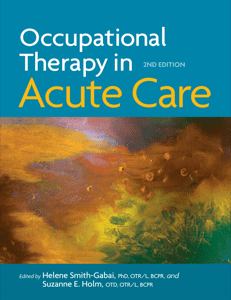Abstract
Occupational therapy is an allied health profession with an underlying belief that engaging in occupations promotes both health and wellness. While working in a hospital setting, which operates predominantly in a hierarchical and paternalistic medical model, occupational therapy professionals can find it difficult to reconcile the realities of this environment with their core professional values.
The challenge of acute care practice is looking beyond a specific medical condition and seeing the whole person. Working within a medical setting also requires an understanding of medical conditions and how illness affects occupational performance. What sets occupational therapy apart from other professions is an understanding of the totality of a patient’s occupational profile and the importance of helping patients reclaim important roles and routines.
Occupational Therapy in Acute Care, 2nd Edition, written collaboratively by occupational therapists with acute care and teaching experience, is designed for practitioners working in a hospital setting and others seeking to learn more about this important but often overlooked area of practice. Illustrated chapters offer an understanding of the various body systems, common conditions, diseases, procedures, and typical medical management and how they relate to occupational therapy practice.
This book has been reorganized and updated with evidence-based practice. New for this edition are chapters on the acute care context, services, and disciplines; standardized assessments and G-codes; hospital equipment; trauma; orthotics; physical agent modalities; and creating a positive patient experience. This edition also features downloadable handouts to be used with patients and videos to enhance practice.
Details
Table of Contents
Occupational Therapy in Acute Care, 2nd ed.
-
Front Matter
i2

- PART I: Foundations of Occupational Therapy in Acute Care 120
-
1. Occupational Therapy in the Acute Care Context: An Evolving Role
322

-
2. Evidence-Based Practice in Acute Care
2342

-
3. Evaluation of Acute Care Patients
3756

-
4. Standardized Assessments and G-Codes
6382

-
5. Ethics in Acute Care
7796

-
6. Discharge Planning in Acute Care: A Consultative Partnership
83102

-
1. Occupational Therapy in the Acute Care Context: An Evolving Role
322
- PART II: Understanding the Acute Care Environment 97116
-
7. Acute Care Services and Disciplines
99118

-
8. National Patient Safety Goals and Fall Prevention Techniques
107126

-
9. Intensive Care Unit
115134

-
10. Common Diagnostic Tests
137156

-
11. Laboratory Values
149168

-
12. Fundamentals of Pharmacology for Occupational Therapy
175194

-
13. Hospital Equipment
183202

-
7. Acute Care Services and Disciplines
99118
- PART III: Body Systems 209228
- PART IV. Conditions and Disorders 441460
-
Orthopedics and Musculoskeletal Disorders
443462

-
23. Infectious Diseases and Autoimmune Disorders
471490

-
24. Oncology
489508

-
25. Trauma
511530

-
26. Dizziness
539558

-
27. Bariatrics: Implications for Acute Care Practice
549568

-
28. Altered Mental Status
561580

-
29. Burns
571590

-
30. Dysphagia
583602

-
31. Transplantation
599618

-
32. Low Vision: Strategies for Successful Intervention
627646

-
33. Orthotics
639658

-
Orthopedics and Musculoskeletal Disorders
443462
- PART V. Working With Clients in Acute Care 653672
-
Index
719738

